?Sketch the shape and orientation of the following types of orbitals: (a) \(p_{x}\), (b) \(d_{z^{2}}\), (c) \(d_{x^{2}-y^
Chapter 6, Problem 6.64(choose chapter or problem)
Sketch the shape and orientation of the following types of orbitals:
(a) \(p_{x}\),
(b) \(d_{z^{2}}\),
(c) \(d_{x^{2}-y^{2}}\).
Text Transcription:
p_x,
d_z2,
d_x2 - y2
Unfortunately, we don't have that question answered yet. But you can get it answered in just 5 hours by Logging in or Becoming a subscriber.
Becoming a subscriber
Or look for another answer
